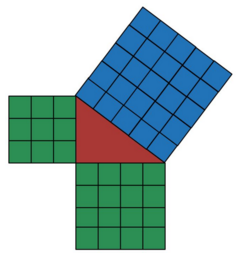Identify the Theorem

What theorem does this image represent?
This section requires Javascript.
You are seeing this because something didn't load right. We suggest you, (a) try
refreshing the page, (b) enabling javascript if it is disabled on your browser and,
finally, (c)
loading the
non-javascript version of this page
. We're sorry about the hassle.
11 solutions
Moderator note:
Nice GIF, do you have other GIFs that demonstrate Pythagoras Theorem nicely?
This is a GIF by the brilliant team .The GIFs we get when we start a streak .
Very cute & intelligent explanation.. If possible create such explanations for other theorems as well 👍
Also Known as Boudhayana's Sulba Sutra.
In response to the Challenge Master :
Nope , but I'll try searching for one on Google ;)
Hey Azhaghu its a Cool Gif! ;)
ok,, Really Brilliant!1
not only verify the area it also obey the volume
Log in to reply
I heard it's a Da Vinci creation , so no doubt it's awesome!
The formula to the Pythagorean Theorem, is that a 2 + b 2 = c 2 , where a, b and c are side lengths of a right angle triangle. Substituting 3, 4 and 5 for a, b and c: 3 2 + 4 2 = 5 2
This formula is used to find the third (unknown) length of a right-angled triangle, when you already know two of the side lengths.
You should mention that c is the hypotenuse, because otherwise your solution can be interpreted as saying that c can be any one of the side lengths, which is not true.
The main idea is that a 2 , b 2 , c 2 represent the area of the squares with side length a , b , c respectively and if we measure, we can see that the sum of the areas of the squares made along the non-hypotenuse sides is equal to the area of the square made along the hypotenuse in the diagram.
Log in to reply
Yes . And could also be mentioned that it is a particular case of general formula that refers to sides and angles. But i don't remember it by heart. Probably somethig about a sen of angle C wich would be 1 or 0
I once dated, Pythagoras' great great great great great great granddaughter... It's all she talked about.
@Steve Varga for real?
At my school we get taught that it is Pythagoras's theorem
The picture is Originally from Boudhayana's Sulba Sutra.. many years prior to Pythagorus.. Please mention the name along with Pythagorus...
Pythagoras theorem shows the squares of the sides
And the cubes given in the figure are perfect squares of 3 , 4 and 5 which is a Pythagorean triplet !
N yeah the gif proves d rest !!
Pythagoras theorem 3^2+4^2=5^2 9+16=25
As number of blocks denote the length of sides
The distance formula would also work for this because it's just a more generalized form of the Pythagorean theorem. I'm curious if they accepted the distance formula as a correct answer. I went with Pythagorean theorem because it's obvious that's the answer they wanted.
With right angled trianles,This theorem is well known that Square of base + square of height is = sqare of hypotenuse. Thus 3 square + 4 square = 5 square.
Moderator note:
Careful with your spelling!
Bonus question : Is Cosine Rule related to Pythagoras Theorem? If yes, which one is the special case of the another? Explain.
Law of cosines is related to pythagorean theorem. Pythagorean theorem is a special case of law of cosines at x = 90, because then anything with cosine in the law of cosines becomes zero (cos 90 = 0)
As square Of 3 + square of 4= square of 5 This shows pythagorean theorem.
Moderator note:
Not quite right. Pythagoras Theorem does not necessarily means that 3 2 + 4 2 = 5 2 . There are other triplets that all satisfy this criteria: 5 2 + 1 2 2 = 1 3 2 , 7 2 + 2 4 2 = 2 5 2 , 8 2 + 1 5 2 = 1 7 2 , etc.
Does Pythagoras Theorem only works for right angled triangles?
The Pythagorean theorem works only for right triangles, but not all right triangles are 3-4-5 right triangles. That is to say, the ratios you included would possibly be valid for right triangles with different side lengths.
Also, the theorem only allows you to find the length of the unknown side of a right triangle, but this doesn't necessarily mean that if you have a sum of squares that it must be a right triangle. The theorem is useful if you have the length two of sides and need to calculate the third.
If I remember correctly, in order to calculate the side length of non-right triangles, you need to know the degrees or radians in the opposite angle and the lengths of the other two sides.
It's the same thing , but worth a mention .